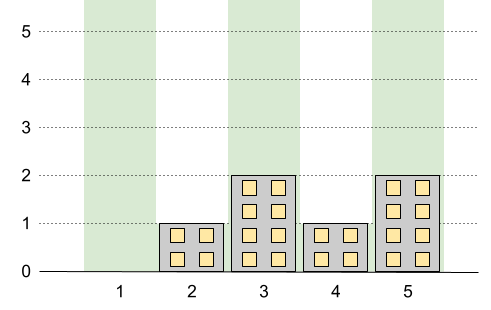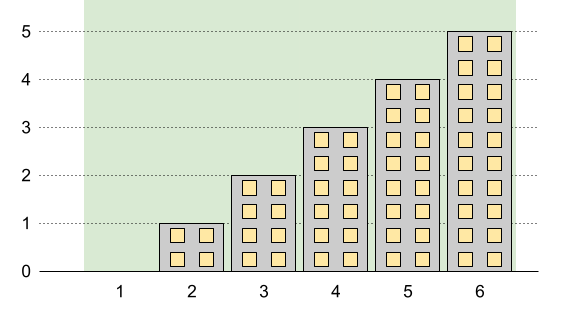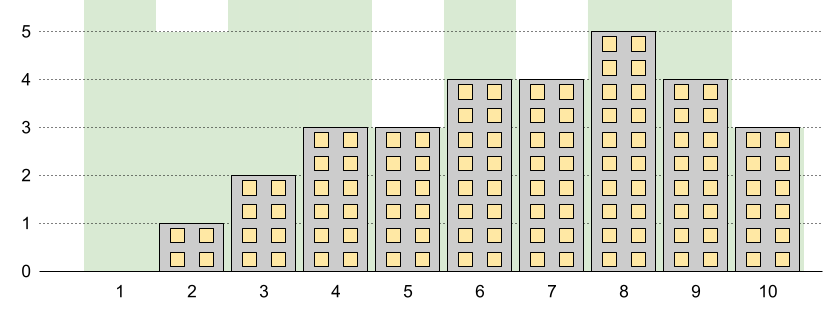LeetCode in Kotlin
1840. Maximum Building Height
Hard
You want to build n new buildings in a city. The new buildings will be built in a line and are labeled from 1 to n.
However, there are city restrictions on the heights of the new buildings:
- The height of each building must be a non-negative integer.
- The height of the first building must be
0. - The height difference between any two adjacent buildings cannot exceed
1.
Additionally, there are city restrictions on the maximum height of specific buildings. These restrictions are given as a 2D integer array restrictions where restrictions[i] = [idi, maxHeighti] indicates that building idi must have a height less than or equal to maxHeighti.
It is guaranteed that each building will appear at most once in restrictions, and building 1 will not be in restrictions.
Return the maximum possible height of the tallest building.
Example 1:

Input: n = 5, restrictions = [[2,1],[4,1]]
Output: 2
Explanation: The green area in the image indicates the maximum allowed height for each building. We can build the buildings with heights [0,1,2,1,2], and the tallest building has a height of 2.
Example 2:

Input: n = 6, restrictions = []
Output: 5
Explanation: The green area in the image indicates the maximum allowed height for each building. We can build the buildings with heights [0,1,2,3,4,5], and the tallest building has a height of 5.
Example 3:

Input: n = 10, restrictions = [[5,3],[2,5],[7,4],[10,3]]
Output: 5
Explanation: The green area in the image indicates the maximum allowed height for each building. We can build the buildings with heights [0,1,2,3,3,4,4,5,4,3], and the tallest building has a height of 5.
Constraints:
2 <= n <= 1090 <= restrictions.length <= min(n - 1, 105)2 <= idi <= nidiis unique.0 <= maxHeighti <= 109
Solution
class Solution {
fun maxBuilding(n: Int, restrictions: Array<IntArray>): Int {
if (restrictions.isEmpty()) {
return n - 1
}
val m = restrictions.size
restrictions.sortWith(compareBy { a: IntArray -> a[0] })
for (i in m - 2 downTo 0) {
restrictions[i][1] =
restrictions[i][1].coerceAtMost(restrictions[i + 1][1] + restrictions[i + 1][0] - restrictions[i][0])
}
var id = 1
var height = 0
var res = 0
for (r in restrictions) {
var currMax: Int
if (r[1] >= height + r[0] - id) {
currMax = height + r[0] - id
height = currMax
} else {
currMax = (height + r[0] - id + r[1]) / 2
height = r[1]
}
id = r[0]
res = res.coerceAtLeast(currMax)
}
if (id != n) {
res = res.coerceAtLeast(height + n - id)
}
return res
}
}

